Greetings to all in guitarland. A quick reminder to mark your calendar for next week’s WEBCAST. We are going to blow the speakers on your computer, so don’t be the guy saying, “Oh yeah, I forgot to tune in. How was it!?”. Info at the bottom of this page. This month’s column will feature some of my favorite vintage pedals and effects. These choices will be from my point of view and experience, and as I cannot with expertise speak about effects that I cannot use in the type of music I play (which is blues, old school country, classic rock and 50’s and 60’s R&B). I again welcome all suggestions for your favorite effects.
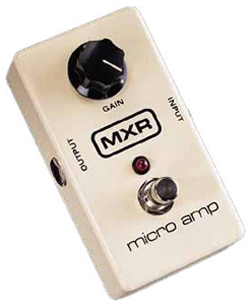
MXR Micro Amp Guitar Effects Pedal
#1: MXR Micro Amp
This is by far the most useful pedal I have ever used/seen. What this pedal does is so simple yet so valuable to any guitarist playing any kind of music. What it does is makes your sound either a bit louder or much louder. Don’t sound like much, but think about it, how many times were you playing and thought gee I would like to be a bit louder without changing my sound.
So before I get all excited, let me tell you what this pedal actually does. The Micro-Amp is an FET preamp with a 0 to 20+ db gain structure that does not color your sound at all (aside from the fact that you are pushing your preamp section of your amp harder which usually causes your sound to be a bit darker). In my effects chain it is my last in line (btw I only use 4 pedals). Over the twenty-five plus years I have owned one I have used it not only as a boost but have also used it to boost line levels when using long cable runs to isolation booths when recording. I have also used it in a pinch when amplifying an acoustic guitar with a piezo pickup and no onboard preamp. One other comment about this pedal, the battery life (especially the early versions with no LED) is extremely long. Yipee!!! Check one out you will not be sorry.
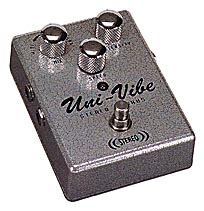
Uni-Vibe Guitar Effects Pedal
#2: Uni-Vibe
Yeah I know Jimi Hendrix used one, and after he died Robin Trower used one on his post Procal Harum albums. There is a reason these cats used one, I think the reason is that there is a magic to the Uni-Vibe that you can’t put a finger on. The best way I can describe it is that it’s thick yet lets the guitars dynamics come through. I have also always believed that it works best with single coil guitars, again I believe this is due to its fatness. IMHO if you want a similar vibe (pun) for your Les Paul or SG use a flanger.
I recommend the original of course, they are not cheap and not too road worthy but they sound unreal. The Dunlop reissues sound okay but I believe the Line 6 Modulation POD Uni-Vibe sound is better and cleaner. I also recommend the FulltoneDeja-Vibe.
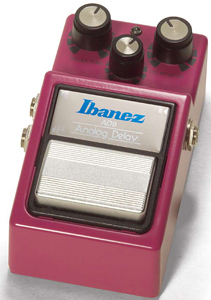
Ibanez Maxon AD9 Analog Delay Guitar Effects Pedal
#3: Ibanez (Maxon) AD9 analog delay
The AD9 is a great sounding analog delay, with three controls, feedback (repeats), delay time, and mix. These pedals were made in the late 80’s if my memory serves me correct. Before my brief analysis of this pedal let me proudly say that back in the late 80’s when we all got sucked into the idea that “digital delay was so much cleaner” mentality, I remember saying to my friend Jimmy Agnello “I dunno I like analog delays alot better”. Well now I think we all know that if it’s a toss up between sounding like Chet Atkins or Big Country…. well you get the picture.
When comparing the AD9 to its predecessor the AD909 I think the AD9 sounds more guitar friendly and less science-fictionary. I think that the AD9 sounds more Echoplexy than the Boss DC-2, and lets face it isn’t that what we want.
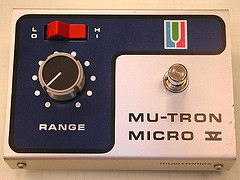
Musitronics Mutron V Envelope Follower Guitar Effects Pedal
#4: Musictronics Mutron Micro V Envelope Follower
I bought one of these little buggers back in the early 80’s when I was playing bass and wanted to funk up my sound a bit. It worked pretty good on the bass, but when I shifted over to guitar and finally got the nerve to plug it in it really started speaking in funky tongues. Although all it had was one button, dude that’s all it needed. It also sported a switch that went from high to low, which accentuated the higher or lower frequencies. I can’t say for sure whether Frank Zappa used the MicroV or the full sized Mutron for his auto-wah effect but this pedal cops his signature auto-wah effect perfectly.
I also love the Ibanez offering from their early small button series, but this one sounds even better. Another aspect of this pedal that I like is that it is a bit more touch sensitive than any other Envelope follower I have tried.
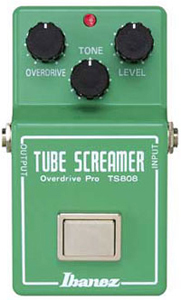
Ibanez TS808 Tube Screamer Overdrive Pro Guitar Effects Pedal
#5: Ibanez TS808 Tube Screamer
What can you say about a pedal that sells for ten times its initial price only 20 years later. The 808 in its original form had a small square on/off button on top, three knobs (distortion/tone and volume) and an LED light.. For most of us that have used this pedal the best way to describe it is its warm sounding even at its most trebly setting and it compliments the sound of any guitar and amp combination it is used with.
The pedal has its own sound no doubt, but part of that sound is its ability to not color your sound so much. To me it’s the perfect distortion pedal if you are prone to go back and forth from a cleaner sound to a slightly dirtier sound. The 808 is virtually indestructible and its battery life is pretty good.
Now onto the reissues and clones, first I will say that I like the reissue Ibanez TS808 that is currently available. I have A/b’ed it with a few of my original 808’s and they sound almost identical. I wish the lED was briter as on the originals you could gauge your battery life with it. The Maxon version which is in a smaller, flimsier case is not roadworthy at all. It sounds similar but not as close as the Ibanez reissue. The on/off switch is noisy and the pots are too close together for that foot adjustment we all have gotten used to with the original 808.
I must also mention a fellow Vermonter and electronics whiz Mr. Denny Coleman make a great version of this pedal under the name Musicians Junkyard Screamer this pedal is very close to the original, although I will say that it has a texture that my 808 does not, a kind of barely audible octave overtone that I like very much. Check it out.
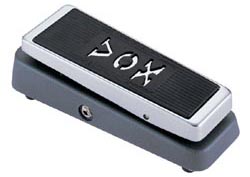
Vox Clyde McCoy WahWah Guitar Effects Pedal
#6: The Vox Clyde McCoy wahwah pedal (model V848)
Yes my friends I know that there are many wahwahs that are classics and similar (Cry Baby’s etc.). I owned and used an original “Clyde” for years without knowing what a classic and valuable pedal it was. During this time I was using a Cry Baby also and was easily able to hear the difference between the two pedals.
Now I will also say that over the years I have had many guitar players complain about their wahs, and most of their complaints were based on the pedals not being setup right. The “throw” or the aperture (opening) needs to be set to your own taste, and that usually rights whatever problems you might have. (That adjustment is easily made by loosening the retainer screw which holds a plastic piece that comes down from the pedal and once this screw is loose you can adjust the throw on the potentiometer that controls the wah effect.
As far as the sound is concerned, I think that what separates the Clyde from the CryBaby is that it sounds a bit fatter in the low end and a bit less harsh in the open position. I also think that is has a nicer notch in the middle which helps for that wahwah sustain that Jimi used so well. I have never been a fan of the Morley pedals as their throw is too big and I can’t use them comfortably while standing.
Vox has reissued the Clyde with a true bypass and I own four of them and they are great, maybe even a bit cleaner than the originals which is a 50/50 aspect, some might like it, some won’t. I like these so much that I did sell my original Clyde for an insane amount of money.
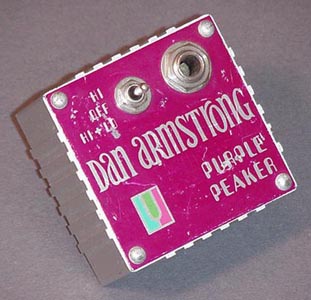
Dan Armstrong Purple Peaker Plug-in Guitar Effects Pedal
#7: Dan Armstrong Purple Peaker Plug-in effects
These very cool little pedals were designed by Dan himself. They plugged right in the guitars output, which makes them IMHO a more studio friendly effect, but with a very simple reverse wiring you can plug them into the amp, and you’re good to go. The real winners of the line were the Orange Squeezer and Purple Peaker. Both of these add-ons were used by RyCooder, and David Lindley, and Mark Mothersbaugh of Devo used the Blue Clipper Fuzz duct taped to his guitar.
Here’s some really good news, after some really poor quality Korean copies of these high quality units were made back in the 90’s, these great little units are being handmade again in the USA using the original designs, and they sound great!!! Rumor has it that there will be some stomp box versions out soon too!
Now here’s some quickies….
- Vox Tonebender: classic 60’s fuzz box
- Boss pitch shifting delay pedal: very cool pedal for that quick harmony
- Ibanez Phase Tone: early script lettering one button, one pot, not the most versatile phaser but a great one
- MXR Dyna Comp: great compressor, can be very subtle as well as a real scwelcher. Also a great combo with any Chorus/phaser/flanger
- Boss Distortion (Orange Box): great direct into the board distortion effect, used it many times in the studio always with a shocked look from the engineer.
- Boss CE-3 Chorus: “the” chorus pedal as far as I can tell, it has the sound. It’s versatile, not very noisy and sturdy as a Tonka Toy.
- DeArmond Volume Pedal: until the Morley volume pedal strolled onto the scene this was the only show in town. The DeArmond was the industry standard throughout my formative years in this business. Keyboard players used it as well as horn players as well, but as a guitar player it affords you the luxury of leaving your guitar full out taking advantage of its full tonal voice.
- MXR Phase 90: another industry standard, sturdy, sounds great how can you look yourself in the mirror knowing you don’t have one kicking around your effects bag.
- Sam Ash fuzz box: red box probably made by Unicord, anyway old school fuzz box and ugly as a monkey’s rear end.
Some many effects so little time….
Please send me your favorite effects and I will add them in future columns.

I’m not much into effects pedals, and have only owned two over the course of many years, but the one I’ve hung onto and used with some frequency is the Voodoo Labs Tremolo, which sounds just gorgeous when the song calls for that effect.
Great article. Especially liked the Purple Peaker – I’ll have to check that out.
Btw The boss Orange disortion is the DS1.
The Ibanez 10/power series contains some gems. I use the Swell Flanger (SF-10) and the DDL (no 10 after this one.. it’s just DDL) Digital Delay. I also have a SC-10 Super Stereo Chorus that belongs to my friend.
I think the delay may be best of all and competes with the flanger for collectors value. It does what I want for the most part, but sometimes I would like endless, spacey delay. The flange gets crazy, gnarly feedback and also some nice note shifting sounds – maybe that’s the “swell”.. certainly not like other flangers to me. The chorus is just kind of standard. These are actually the only pedals I own now. Sometimes I run them all together.
More intriguing stuff! Thanks, Joey! The one that interests me the most is the micro amp. Sometimes I just want to get a bit louder–that’s all!
You never said what the Purple Peaker and Mutron actually do.
I’ve got a Fulltone Fat Boost (original version) that I like a lot. It adds some “meat” to the single coil sound of my Strat, clean or overdrive. And speaking of overdrive, after trying all sorts of pedals, I went with the Deltalabs TO-1 (Tube Overdrive-1). As I understand it, Deltalabs used to be a boutique pedal maker, but got bought out by Guitar Center. The TO-1 sound warm and smooth, with just enough midrange hump to make the guitar stand out in the mix. Chords sound like chords. No fizziness! Cost me $40, new. Actually, I like it much better than the new Tube Screamers (which sound harsh, to me), but it all depends on your rig, of course.
I used to have an MXR Phase (90, I guess) pedal. It sounded great on my bass guitar. The only thing I didn’t like was that you couldn’t control the intensity of the effect, only the speed. In the studio, of course, you could address that by running it through a channel insert.
Really enjoyed this article. Two of my personal favorites however would definitely be the old EHX Big Muff NYC and the classic bulky 5 knob Memory Man. But yeah, other than those I’d have to agree with you on all of these.
Joey – Great column as always! Question – what are your thoughts on the Ibanez Tube Screamer Classic TS10? I’ve used one for years and never really used an original – wonder how much I’m missing. Also, since I know you like unconventional – for the rare times you want a Flanger, try the Boss Bass Flanger BF-2B. I always found guitar flangers to be harsh. The Bass Flanger gives a guitar a nice fat bottomed flange effect. Try it – you’ll like it!!
Cheers.
SR
Nice article. I don’t agree at all about the Tubescreamer–it colors my guitar tone more than any other overdrive I’ve used, though not in a bad way–but otherwise, these are some seriously cool pedals. Incidentally, on the vibe clones, the Danelectro Cool Cat Vibe can get some pretty awesome swirl going, though it takes a five-minute no-parts switch mod if you want to be able to use it live.
hey now, some of us actually like that Big Country sound! Stuart Adamson and Bruce Watson had some of the most unique guitar tones in the history of the instrument, especially on albums like “The Crossing” and “The Seer”. the combination of the MXR Pitch Transposer, some chorus and delay helped make them undeniably unique. like a lot of 80’s bands, they often used solid state amps (especially Stuart), so there was that “sterile” sound, but i don’t think it was necessarily a “bad” tone, unlike a lot of other more New Wave-type bands who seemed to enjoy sounding like amplified icepicks.
i think the great thing about both Bruce and Stuart’s setups is that they were deceptively simple, but between the MXR Pitch Transposer and their willingness to try unorthodox settings on the few other effects they used, they managed to create a new sound that no other band since has really been able to replicate. that, along with Stuart’s brilliant songwriting ability, really made Big Country stand apart from other 80’s bands and why they still have an extremely loyal following, despite Stuart’s passing ten years ago.
Old Bigmuffs are a must. I specialy like the Sovtek, really don’t know why but it’s easier to get the sound with any guitar/amp combination. The Boss old trusty DS1 is THE DISTORTION, no discussion. Other pedals that must be named are ProCo Ratt 2 and the MXR Distortion +, the early ones that give a warm creamy distortion full of colour.
I had a Small Stone Phaser back in the early 80s (https://www.youtube.com/watch?v=6F1EaPtxhxs for a video). Man that thing sounded great, but it was fragile as heck. I wound up sending it back in exchange for the Boss PH-1r, which was built like a tank and still works. But I preferred the Stone’s sound.
I have a few pedals, but the two I couldn’t do without are:
Strymon OB1 – principally because, as with your first choice, you press it and the guitar goes louder, without really colouring the tone. Essential for solos. I use the compressor in it a little, but not so much as you’d notice,
Strymon El Capistan – the best tape echo I’ve found, particularly when you get in to the secondary controls (hold the two main buttons down and adjust the knobs for spring reverb, drive, etc).
I had a cheapo Nobel Tremolo which eventually fell apart, that had something about I’ve not really replaced, even with the (on paper much better) Fulltone Supa-Trem.
you have the vox model right for the wah . . . . you forgot one of the best tonebenders ever – Pedalworx Benderoverunder! I think the new tim pierce signature overdrive will be pretty sweet too.
I had a Electro Harmux[spelling] Black Finger the old one 3 knobs in upside down V shape,don’t know what happened to it must have lent it to a friend.Anyway step on it “Leslie West” well nobody sounds like that
” The Micro-Amp is an FET preamp with a 0 to 20+ db gain structure that does not color your sound at all”
Maybe your newer one there with an LED doesnt do this, but my original issue sure does color the tone, in a good way. I have a 1970 Univox Univibe, its my prized possession out of all my pedals, ive never heard a recreation sound a milky and cool as it, though there are some decent clones out there.
I used different effects that this guy, i like the old yellow stereo chorus from MXR, echo is an old echo plex, etc… anyone trying to chase down that old cool pagey hendrix wah sound might want to look at those dunlop hendrix wah’s that they started putting out back around 2007? ive had tones, old opriginal ones and the hendrix/dunlop i got sounded so much better i sold all my old ones, though i did mount it in a reissue vox v847 casing (the dunlop casing are very cheap)
prices on the old pedals have been rediculous for years, glad i was buying old analog pedals all through the 80’s when everyone else was dumping for digital… i have just about the whole 70’s MXR line of pedals in script logo’s and i doubt i paid any more than $150 for them all.
The “univibe” photo in your article is not really a Univibe at all. It’s really a chorus unit with the univibe name on it. It’s not a bad sounding chorus, but sounds nothing like a real univibe. There is/was a reissue, but the Fulltone vibes, the HK and even the Voodoo Labs are closer. Sone high dollar lobes out there as well.
So many pedals! I buy tons of them. Plug in a handful and go to town. I don’t know that I have any particular favorites. Just like getting different sounds. Used to drive my bandmates crazy because I sounded different at every practice and show.
I have the original Maestro Fuzztone. Bought it back in ’65 and it was expensive in ’65 dollars! Still have an Electro Harmonix Small Stone Phaser. Loved that pedal. Have to dig it out one of these days. Also have the MXR Micro Amp. The foam has all crumbled!